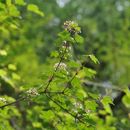en
names in breadcrumbs


Flowering from June to July; fruiting from September to October.
Viburnum kansuense is occurring in Gansu, Shaanxi, Sichuan, Xizang, Yunnan of China.
Shrubs, deciduous, 1-3 m tall. Branchlets of current year pale-brown, glabrous; branchlets of previous year gray or gray-brown, with dispersed lenticels; winter buds with 2 pairs of separate scales. Stipules 2, subulate; petiole 2.5-4.5 cm long, glabrous; leaf blade broadly ovate to oblong-ovate or obovate, 4-8 cm long, 3-7 cm wide, papery, abaxially adpressed long hairy, densely stellate-pubescent in vein axils, adaxially sparsely stellate-pubescent throughout or only on veins, 3-lobed, 3-5-palmatinerved, base truncate to subcordate or broadly cuneate, middle lobe largest, lobes irregularly dentate, apex acuminate or acute. Inflorescence a compound umbel-like cyme, 2-4 cm in diameter, pubescent; peduncle 2.5-3.5 cm long, with 5-7 rays. Flowers on rays of the second and the third orders. Calyx tube purple-red, glabrous. Corolla reddish, rotate; lobes suborbicular, slightly exceeding tube, base narrow, margin slightly erose. Stamens slightly longer than corolla; anthers red-brown, globose. Stigmas 2-lobed. Fruit red, ellipsoid or subglobose; pyrenes compressed-ellipsoid, with 2 shallow dorsal grooves and 3 shallow ventral grooves.
Growing in Abies forests, mixed forests; 2200-3400 m.